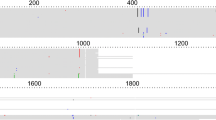Abstract
The phylogenetic relationships of Lactarius volemus and its relatives were investigated using the nucleotide sequences of the nuclear-encoded large subunit ribosomal DNA (LSU rDNA). Thirty-six sequences from L. volemus, L. corrugis, and L. hygrophoroides, including three sequences obtained from the GenBank database, were used in this study. Samples studied were divided into four major subclades (A–D) in both neighbor-joining (NJ) and maximum-parsimony (MP) trees. Lactarius volemus and L. corrugis formed one large clade in both NJ and MP trees (bootstrap value, 100%), which was divided into three subclades (A–C). Subclade A included three clusters of L. volemus strains, i.e., velvet, red, and Chinese types. Subclade B included the common and red types of L. corrugis. Subclade C included the common and yellow types of L. volemus. Subclade D included only one type of L. hygrophoroides. An analysis of the fatty acid composition supported the divisions found in the molecular analysis. Analyses of nucleotide sequence, fatty acid composition, morphological characteristics, and the taste of the fruiting bodies all led us to conclude that the common, velvet, red, and Chinese types of L. volemus, and the common and red types of L. corrugis, may each belong to different species, subspecies, or varieties. Further studies with more material from a wide range of regions are required to conduct taxonomic revision of these types. The LSU rDNA region may be a useful tool to investigate phylogenetic relationships within the section Dulces of the genus Lactarius.
Similar content being viewed by others
References
H Akaike (1974) ArticleTitleA new look at the statistical model identification IEEE Trans Autom Contrib 19 716–723 Occurrence Handle10.1109/TAC.1974.1100705
D Drehmel J-M Moncalvo R Vilgalys (1999) ArticleTitleMolecular phylogeny of Amanita based on large-subunit ribosomal DNA sequences: implications for taxonomy and character evolution Mycologia 91 610–618 Occurrence Handle10.2307/3761246 Occurrence Handle1:CAS:528:DyaK1MXlsFChs74%3D
U Eberhardt (2002) ArticleTitleMolecular kinship analyses of the agaricoid Russulaceae: correspondence with mycorrhizal anatomy and sporocarp features in the genus Russula Mycol Progr 1 IssueID2 201–223 Occurrence Handle10.1007/s11557-006-0019-6
J Felsenstein (1985) ArticleTitleConfidence limits on phylogenies: an approach using the bootstrap Evolution 39 783–791 Occurrence Handle10.2307/2408678
J Floch M Lees GH Sloane Stanley (1957) ArticleTitleA simple method for the isolation and purification of total lipids from animal tissues J Biol 226 IssueID1 497–509
J Heilmann-Clausen A Verbeken J Vesterholt (1998) The genus Lactarius: Fungi of Northern Europe, vol 2 Danish Mycological Society Espergærde
LR Hesler AH Smith (1979) North American species of Lactarius University of Michigan Press Ann Arbor
DG Higgins AJ Bleaby R Fuchs (1992) ArticleTitleCLUSTAL V: improved software for multiple sequence alignment Comput Appl Biosci 8 189–191 Occurrence Handle1591615 Occurrence Handle1:STN:280:By2B2svitF0%3D
T Hirata S Takamatsu (1996) ArticleTitleNucleotide sequence diversity of rDNA internal transcribed spacers extracted from conidia and cleistothecia of several powdery mildew fungi Mycoscience 37 265–270 Occurrence Handle10.1007/BF02461299
JS Hopple R Vilgalys (1999) ArticleTitlePhylogenetic relationships in the mushroom genus Coprinus and dark-spored allies based on sequence data from nuclear gene coding for the large ribosomal subunit RNA: divergent domains, outgroups and monophyly Mol Phylogenet Evol 13 1–19 Occurrence Handle10508535 Occurrence Handle10.1006/mpev.1999.0634 Occurrence Handle1:CAS:528:DyaK1MXmt1OmsLc%3D
A Humpert EL Muench AJ Giachini MA Castellano JW Spatafora (2001) ArticleTitleMolecular phylogenetics of Ramaria and related genera: evidence from nuclear large subunit mitochondrial small rDNA sequences Mycologia 93 465–477 Occurrence Handle10.2307/3761733 Occurrence Handle1:CAS:528:DC%2BD3MXksVaju7g%3D
R Imazeki T Hongo (Eds) (1989) Colored illustrations of mushrooms of Japan, vol 2 Hoikusha Osaka
PM Kirk PF Cannon JC David JA Stalpers (2001) Dictionary of the Fungi EditionNumber9th edn CAB International Oxon
JM Moncalvo R Vilgalys SA Readhead JE Johnson TY James MC Aime V Hofstetter SJW Verduim E Larsson TJ Baroni RG Thorn S Jacobsson H Clemenson OK Miller (2002) ArticleTitleOne hundred and seventeen clades of euagarics Mol Phylogenet Evol 23 357–400 Occurrence Handle12099793 Occurrence Handle10.1016/S1055-7903(02)00027-1 Occurrence Handle1:CAS:528:DC%2BD38XltVKrt7o%3D
T Nara (2004a) ArticleTitleOn L.volemus and its relative species 1 (In Japanese) Kinkonkai Tuushin 97 5–9
T Nara (2004b) ArticleTitleOn L.volemus and its relative species 2 (in Japanese) Kinkonkai Tuushin 98 5–11
D Posada KA Crandall (1998) ArticleTitleModeltest: testing the model of DNA substitution Bioinformatics 14 817–818 Occurrence Handle9918953 Occurrence Handle10.1093/bioinformatics/14.9.817 Occurrence Handle1:CAS:528:DyaK1MXktlCltw%3D%3D
Y Shimono M Kato S Takamatsu (2004) ArticleTitleMolecular phylogeny of Russulaceae (Basidiomycetes; Russulales) inferred from the nucleotide sequences of nuclear large subunit rDNA Mycoscience 45 303–316 Occurrence Handle10.1007/s10267-004-0189-5 Occurrence Handle1:CAS:528:DC%2BD2MXpsFaitg%3D%3D
R Singer (1986) The Agaricales in modern taxonomy, 4th edn Koelz Koenigstein
Y Suyama K Kawamuro I Kinoshita K Yoshimura Y Tsumura H Takahara (1996) ArticleTitleDNA sequence from a fossil pollen of Abies spp. from Pleistocene peat Genes Genet Syst 71 145–149 Occurrence Handle8828176 Occurrence Handle10.1266/ggs.71.145 Occurrence Handle1:CAS:528:DyaK28Xmtlygsr8%3D
DL Swofford (2001) PAUP*: phylogenetic analysis using parsimony (and other methods) 4.0b 8a Sinauer Sunderland, MA
K Tamura M Nei (1993) ArticleTitleEstimation of the number of nucleotide substitutions in the control region of mitochondrial DNA in humans and chimpanzees Mol Biol Evol 10 512–526 Occurrence Handle8336541 Occurrence Handle1:CAS:528:DyaK3sXks1CksL4%3D
Author information
Authors and Affiliations
Corresponding author
About this article
Cite this article
Shimono, Y., Hiroi, M., Iwase, K. et al. Molecular phylogeny of Lactarius volemus and its allies inferred from the nucleotide sequences of nuclear large subunit rDNA. Mycoscience 48, 152–159 (2007). https://doi.org/10.1007/s10267-006-0346-0
Received:
Accepted:
Published:
Issue Date:
DOI: https://doi.org/10.1007/s10267-006-0346-0




